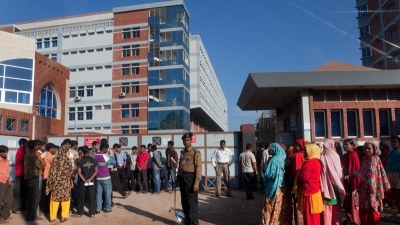The Bangladesh Development Update April 2013 predicts that GDP growth in fiscal year 2013 is likely to fall to around 6 percent compared with 6.3 percent in fiscal year 2012. Cushioned by strong remittances and robust service sector performance, the country can still sustain this slower, yet healthy growth rate. Coupled with remarkable progress on achieving the Millennium Development Goals (MDGs), Bangladesh has the potential to capture at least 15 million jobs and reach the target of 8 percent growth in the medium-term. The outlook is heavily dependent on whether Bangladesh can successfully seize opportunities and manage risks.
Recent Economic Developments
GDP growth in FY 2013 to fall to around 6 percent from 6.3 percent in FY 2012: Weak exports and investments due to the euro-area crisis, domestic supply constraints and intensified unrest in the country are likely to have contributed to this slower growth.
Inflation has declined to 8 percent in March 2013 from a peak of nearly 11 percent in February 2012 reflecting declines in both food and non-food inflation. The 7.5% inflation target for FY13 is still achievable, if there is stability in global commodity prices, functioning of the domestic supply chain is not disrupted by political unrest and monetary caution is maintained.
External balance has turned positive, with a record increase in reserves to over US$ 14 billion by end of March 2013. This reflects the country’s strengths in attracting remittances and foreign assistance, and weaknesses in the form of depressed domestic demand leading to a decline in imports.
Financial development suffered, with Bangladesh slipping one point in the Financial Development Index and now being ranked 57th out of 62 economies. Corporate governance failures led to deteriorating stability of the banking sector and non-bank institutions, along with a lack of confidence in the capital market.
Prudent monetary management led to sustained growth and macroeconomic stability. Monetary growth rates have been on track for the first half of the fiscal 2013, however the shift toward monetary easing in the second half may be premature.
Development Progress
Progress on the Millennium Development Goals (MDGs) has been remarkable. Of the 28 MDG targets, 3 have already been achieved. Bangladesh is on track to achieving 11 MDG goals and needs to provide more attention to the remaining 14.
Bending the arc of poverty reduction, the number of poor in Bangladesh declined by 15 million during 2000-10 compared with only 2.3 million decline in the previous decade. Several non-consumption-based welfare measures also improved. Growth of labor income and lower dependency ratio were the main drivers of this impressive rate of poverty reduction.
“Bangladesh’s poverty reduction was almost twice as fast as that experienced by the rest of the world,” observed Salman Zaidi, Lead Economist.
Prosperity shared in 2000-10 decade was far better than in the preceding ten years. Bangladesh has stable income distribution with positive consumption growth in all deciles. The country was among the 18 highlighted countries of the South with greater gains in Human Development Index between 1990 and 2012 than expected from their previous performance.
However, further depth and breadth in development is needed. Bangladesh continues to have the highest rate of poverty relative to its South Asian counterparts. Certain pockets of poverty lag far behind national average, such as urban slums, the hill tracts and coastal belts. Major challenges include, enrolling the last 10% of hard-to-reach children, enhancing quality of education, reducing gender disparity in tertiary education and addressing the threats of climate change.
Development Opportunities
Bangladesh has a historic opportunity to reach 8% growth. International investors are looking for low-cost manufacturing in Bangladesh, which has a rising share of working-age population. This growing and abundant force is currently under-utilized. Productivity of Bangladesh workers are at par with China in well managed firms with five-times lower wages.
Bangladesh can seize this opportunity to capture at least 15 million jobs. The challenge is to create conditions for faster growth of productive jobs outside of agriculture, especially in organized manufacturing and services. To begin the process of creating 15 million jobs over the next decade, the Bangladesh Economic Zones Authority (BEZA) has to dedicate 40,000 acres for economic zones, the PPP Office has to manage the tendering of infrastructure, the Bangladesh Bank has to reduce the cost of trade finance and the Board of Investment (BoI) as to promote the country to investors.
Outlook and Risks
The global growth is projected to increase in 2013. The outlook for Bangladesh depends on whether it can successfully seize opportunities and manage risks. Bangladesh has to diversify export products and markets to accelerate economic growth.
Some of the looming risks include the prospect of fragile recovery of the Euro area economies and the policy uncertainties in the US, along with possible backlash from recent compliance and labor safety issues, might affect the readymade garments (RMG) industry of Bangladesh. Uncertainties surrounding the reopening of traditional migrant labor markets in Middle East would hamper migration and remittance flows. An immediate hindrance to growth is the political complexity and frequent wide-spread violence of late in Bangladesh.
Time-bound opportunities for investment and job creation will slip away if Bangladesh is unable to act quickly. The risks identified are higher in the near-term.
“If the risks materialize, policy adjustments primarily through fiscal channels and exchange rate will be needed,” says Zahid Hussain, Lead Economist.
Finally, restoration of political stability will become the precondition for development to move forward.

